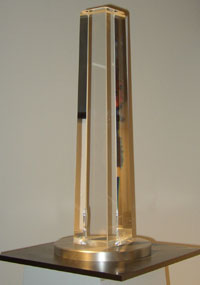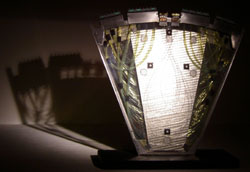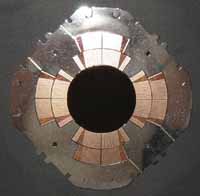Fermilab debuts in the Museum of Modern Art in New York City
More information about Fermilab's contributions to Signatures of the Invisible
|
Lead Glass
Lead glass from a particle detector used and to study charm and anticharm quarks in an experiment at Fermi National Accelerator Laboratory. The glass contains sixty percent lead oxide, more lead than in decorative lead glass. Incoming particles from an accelerator beam strike lead nuclei in the glass to produce electromagnetic showers that generate light. The amount of light tells physicists the energy of the incoming particles.
|

|
|
Forward Preshower Module/ DZero Detector
Forward Preshower wedge, a detector module from the DZero experiment, now operating at Fermilab, built by a joint collaboration of representatives from Brookhaven National Laboratory, the State University of New York at Stony Brook, University of Illinois at Chicago, and Fermilab.
|

|
The Forward Preshower module is a particle tracking device used in the DZero Experiment at Fermilab's Tevatron particle accelerator. It contains arrays of plastic triangular scintillating strips in which green wavelength-shifting fibers are embedded. Light generated by particles traversing the scintillator is trapped in these fibers and transported at the black connectors to light sensitive detectors. The connectors have been diamond-polished to optimize the light yield from the device. The strips are assembled into trapezoidal sections that are bent three-dimensionally to fit the surface of a large sphere. Clear fibers disperse from the center of a module, delivering rich, blue LED light into the green fibers to monitor the system's performance. The module is fully assembled by-hand and has been designed to optimize its physics capabilities and to signify a clash between symmetry and spontaneity.
|
|

Large Hadron Collider Interaction Region Quadrupole Magnet Cross-Section
A cross-section through the center of a superconducting magnet made at Fermi National Accelerator Laboratory for the interaction region of the Large Hadron Collider, a particle accelerator at CERN in Switzerland. The interaction region is the area where two beams of particles collide head on. The beams are accelerated through the hole in the center of the section, and are focused to a spot less than a thousandth of an inch in diameter by a magnetic field, created and shaped by coils. The coils are made of niobium-titanium and copper, and when in operation, are cooled to temperatures of near absolute zero (approximately 455 degrees below zero Fahrenheit). At this temperature, they carry a current in excess of 13000 amperes with no electrical resistance. The support structure surrounding the coils is made of stainless steel laminations built to withstand the large magnetic forces applied by the coils when they are in operation.
|
The completed magnet is about 6 meters (20 feet) long, one of eighteen being designed and built by Fermilab as part of the U.S. contribution to the Large Hadron Collider project.
|
|